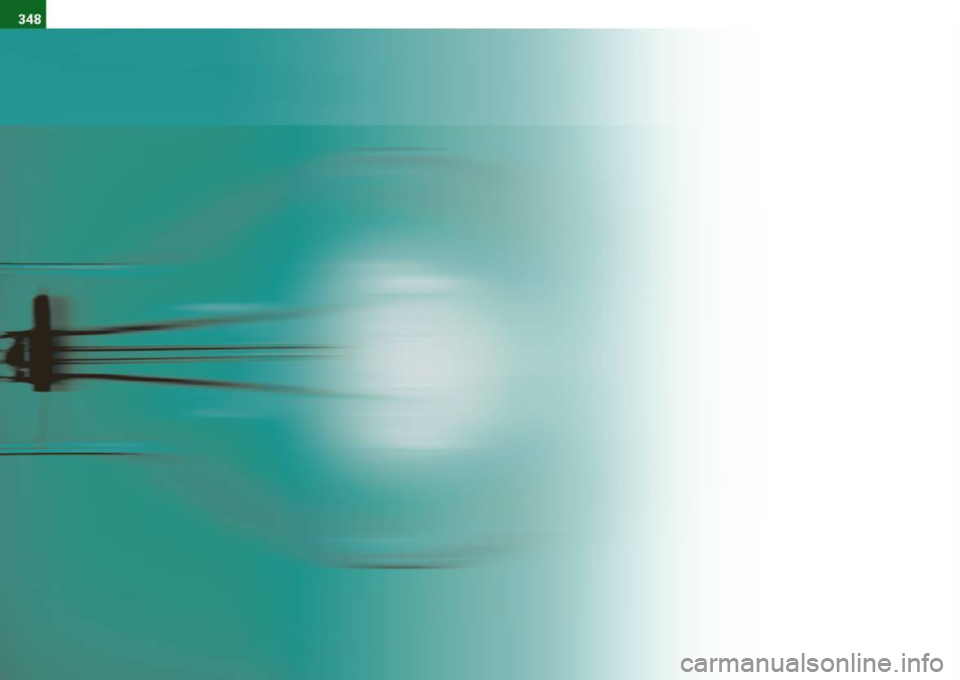AUDI S8 2009 Owners Manual
Manufacturer: AUDI, Model Year: 2009, Model line: S8, Model: AUDI S8 2009Pages: 408, PDF Size: 91.63 MB
Page 341 of 408
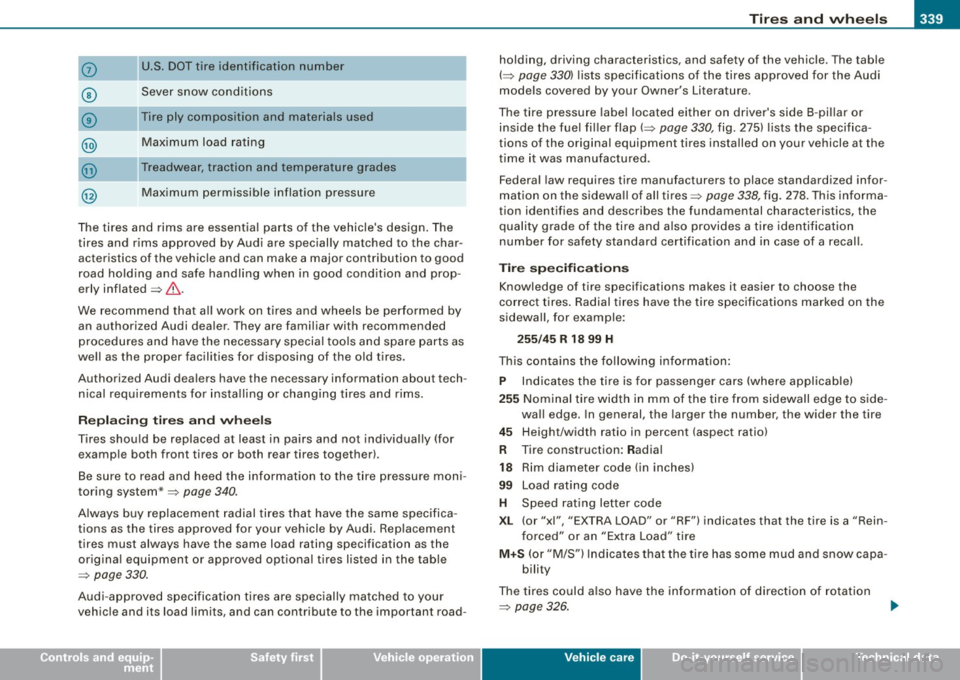
________________________________________________ T_ i _r_e _s_ a_n_ d_ w_ h_ e_e _ l_s __ lR
•
0
-
©
®
U.S. DOT ti re identification number
Sever snow conditions
Tire ply composition and materials used
Maximum load rating
Treadwear , traction and temperature grades
@ Maximum permissible inflation pressure
The tires and rims are essential parts of the vehicle 's design. The
tires and rims approved by Audi are specially matched to the char
acteristics of the vehicle and can make a major contribution to good
road hold ing and safe handling when in good cond ition and prop
erly inflated =>& .
We recommend that a ll work on tires and wheels be performed by
an authorized Audi dealer. They are familiar with recommended
procedures and have the necessary special tools and spare parts as
well as the proper facilities for d isposing of the old tires.
Authorized Audi dea lers have the necessary info rmation about tech
nical requirements for insta lling or changing tires and rims.
R epl ac ing tires and wheels
Tires shou ld be replaced at least in pairs and not individually (for
examp le both front tires or both rear tires together).
Be sure to read and heed the information to the tire pressure moni
toring system*=>
page 340.
Always buy replacement radial tires that have the same specifica
tions as the tires approved for your vehicle by Audi. Rep lacement
tires must always have the same load rating specification as the
origina l equipment or approved optional t ires listed in the table
=>
page 330.
Audi -appr oved spec ification tires are spec ially matched to your
vehicle and its load limits, and can contribute to the important road- holding, driving characteristics, and safety of the vehicle
. The table
(=>
page 330) l ists specifications of the tires approved for the Audi
models covered by your Owner's Literature.
The tire pressure labe l located either on driver's side 8 -pi llar or
inside the fuel fi ller flap(=>
page 330, fig. 275) lists the specifica
tions of the original equipment tires installed on your vehicle at the
ti me it was manufactured.
Federa l law requires tire manufacturers to place standardized infor
mation on the sidewa ll of all tires =>
page 338, fig . 278. This informa
t ion identifies and describes the fundamental characteristics, the
qua lity grade of the ti re and also provides a tire identification
number for safety standard certificat ion and in case of a recal l.
Tire specificat ions
Knowledge of tire specifications makes it easier to choose the
co rrect t ires . Radial tires have the tire specifications marked on the
sidewall, for example:
255 /45 R 18 99 H
This contains the following informat ion:
P Indicates the ti re is for passenger cars (where applicab le)
255 No minal tire width i n mm of the tire fro m sidewall edge to side -
wa ll edge. In general, the larger the number, the wider the tire
45 Height/width ratio in percent (aspect ratio)
R Tire construction: Radial
18 Rim diameter code (in inches)
99 Load rating code
H Speed rating lette r code
XL (or "xi", "EXTRA LOAD" or "RF") indicates that the tire is a "Rein
forced" or an "Extra Load" ti re
M +S (o r "M/S") Indicates that the tire has some mud and snow capa
bility
The tires could a lso have the information of direct ion of rotation
=>
page 326.
Vehicle care I t •
Page 342 of 408
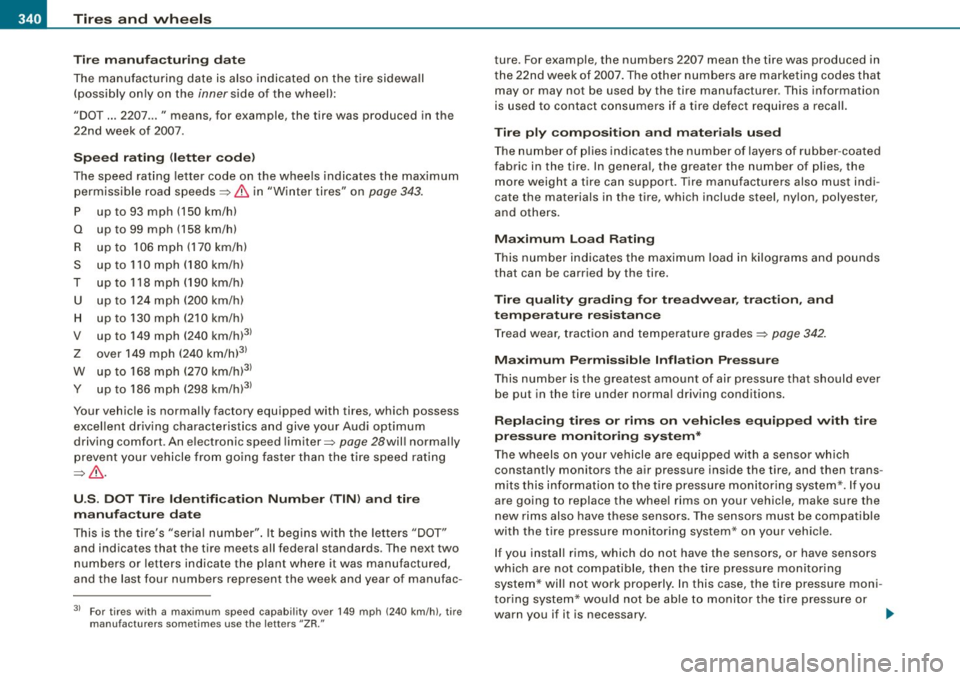
-~_T_ ir_e_ s_ a_ n_d _ w_ h_ e_e _l_s _________________________________________________ _
Tire manuf acturin g date
The manufacturing date is a lso indicated on the tire sidewall
(possibly only on the
inner side of the wheel):
"DOT ... 2207 ... " means, for example, the tire was produced in th e
22nd week of 2007.
Sp eed rating (l ett er code )
The speed rating letter code on the wheels indicates the maximum
permissible road speeds=>
& in "Winter tires" on page 343.
P up to 93 mph (150 km/h)
Q up to 99 mph (158 km/h)
R upto 106mph(170km /h)
S upto110mph(180km/h)
T upto118mph(190km/h)
U up to 124 mph (200 km /h)
H up to 130 mph (2 10 km/h)
V up to 149 mph (240 km/h)3>
Z over 149 mph (240 km/h)3>
W up to 168 mph (270 km/h)3
l
Y up to 186 mph (298 km/h)3>
Your vehicle is normally factory equipped with tires, which possess
excellent driving characteristics and give your Audi optimum
driving comfort . An e lectronic speed limiter=>
page 28will normally
prevent your vehicle from going faster than the t ire speed rating
=> & .
U.S . D OT T ire Identifi cation Number (TIN ) an d tire
m anuf actur e date
This is the tire's "seria l number" . It begins with the letters "DOT"
and indicates that the tire meets all federal standards . The next two
numbers or letters indicate the plant where it was manufactured,
and the last four numbers represent the week and year of manufac-
31 F or tires with a maximum speed capab il ity over 149 mph (240 km/h), t ire
manufactur ers som etimes use the lett ers "ZR."
ture. For example, the numbers 2207 mean the tire was produced in
the 22nd week of 2007. The other numbers are marketing codes that
may or may not be used by the tire manufacturer. This information
is used to contact consumers if a tire defect requires a recall.
T ire ply co mpositio n a nd m ate ria ls used
The number of p lies indicates the number of layers of rubber -coated
fabric in the tire. In genera l, the greater the number of p lies, the
more weight a tire can support. Tire manu facturers also must indi
cate the materials in the tire, which include steel, ny lon, polyester,
and others.
M ax im um Load R ating
This number indicates the maximum load in kilograms and pounds
that can be carried by the tire.
Tire quali ty grading f or tr eadwe ar, trac tion , and
t e mp era tu re resis ta nce
Tread wear, traction and temperature grades=> page 342.
Max imum P ermi ssibl e Infl ation Press ure
This number is the greatest amount of air pressure that should ever
be put in the tire under norma l driving conditions.
Repl acin g tir es o r rim s on vehicles e quippe d with t ire
pr ess ure m onit orin g syste m*
The wheels on your vehicle are equipped with a sensor which
constantly monitors the a ir pressure inside the tire, and then trans
m its this in formation to the tire pressure mon itoring system*. If you
are going to replace the wheel rims on your vehicle , make sure the
new rims also have these sensors. The sensors must be compa tib le
with the tire pressure monitoring system * on your vehic le.
If you install rims, which do not have the sensors, or have sensors
which are not compatible, then the tire pressure monitoring system* will not work prope rly. In this case, the tire pressure moni
tor ing system * would not be able to monitor the tire pressu re or
warn you if it is necessary . .,_
Page 343 of 408

__________________________________________________ T_ ir_e_ s_ a_ n_d _ w_ h_ e_ e_l_s __ _
•
• T he battery inside of the tire pressure sensor has a limited
service life.
• Always drive with the va lve stem caps securely mounted. We
recommend using fac tory insta lled valve stem caps . Ask your autho
rized Audi dealer to replace lost valve stem caps .
T he installation of replacement tires with steel cord body plies in
the tire sidewall may cause malfunction of the tire pressure moni
toring system *, and is not recommended (cord material info rmation
i n molded on the t ire sidewa ll).
A lways check your tire pressure monitoring system * indicator after
replac ing one or more tires on you r veh ic le . If t he tir e pressure
monitoring system * indicator f lashes, or is on, your system is not
wo rking pr ope rly. Your re place ment tire might be i nco m patible wit h
your tire pr essure monitoring system *, or some component of the
t ir e pr ess ure moni toring system * m ay be da maged.
& WARNING
• Using incorrect or unmatched tires and / or wheels or improper
tire and wheel combinations can lead to los s of control , collision
and serious personal injury .
• Alway s use tires , rims and wheel bolts that meet the specifica
tions of original fa ctory -installed tires or other combination s that
have been specifically approved by the vehi cle manufacturer .
• Tires age even if they are not being used and can fail suddenly,
espe cially at high speeds . Tire s that a re more than 6 years old can
only be used in an emergency and then with special care and at
lo wer speeds .
• Never mount used tire s on your vehicle if you are not sure of
their "previous history ." Old used tires may have been dam aged
even though the damage cannot be seen that can lead to sudden
ti re failure and lo ss of vehicle control.
• All four wheels must be fitted with radial tires of the same type ,
size (rolling cir cumference ) and the same tread pattern . Driving
& W ARNING (continued )
with different tires redu ces vehicle handling and can lead to a loss
of control.
• If the spare tire is not the same as the tires that are mounted
on the vehicle -for example with winter tires -only use the spare
tire for a short period of time and dri ve with extra care . Refit the
normal road wheel as soon a s safely pos sible.
• Never drive faster than the ma ximum speed for which the tires
on your vehicle are rated because tires that are driven faster than
their rated speed can fail suddenly .
• Overloading tires cause heat build -up , su dden tire failure ,
includ ing a blowout and sudden deflation and loss of control.
• Temperature grades apply to tires that are properly inflated and
not over or underinflated .
• For te chni cal reasons it is not always po ssible to use wheels
from other vehicles -in some cases not even wheels from the
same vehicle model.
• If you install wheel trim discs on the vehicle wheels , make sure
that the air flow to the brakes is not blo cked . Redu ced airflow to
the brake s can them to overheat , increa sing stopping distances
and causing a collision.
• Run flat tires may only be used on vehicles that were equipped
with them at the fa ctory . The vehicle mu st have a cha ssi s designed
for run flat tires and a factory -installed tire pressure monitoring
s ystem* that indicates a lo ss of tire pressure . Incorrect use of run
flat tires can lead to vehicle damage or accident s. Check with an
authorized Audi dealer or tire specialist to see if your vehicle can
be equipped with run fl at tires . If run flat tires are used , they must
be installed on all four wheels . Mi xing tire types is not permitted.
0 Note
• Fo r techn ica l reaso ns, i t is no t genera lly p oss ibl e to use the
whee l rims from other vehicles . T his can hold true for wheels of the
sa me vehicle type. ..,.
Vehicle care
I t •
Page 344 of 408
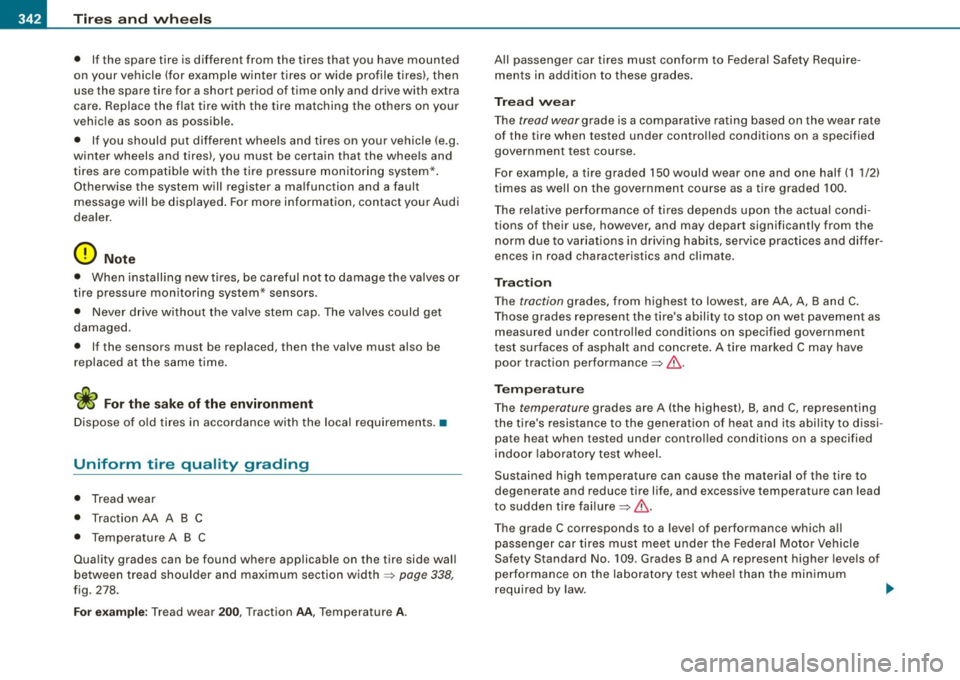
-~_T_ ir_e_ s_ a_ n_d _ w_ h_ e_e _l_s _________________________________________________ _
• If the spare tire is different from the tires that you have mounted
o n your vehi cle (for e xample winter tires or wide profile tires), then
use the spare tire for a short period of time on ly and drive with extra
care . Replace the f lat tire with the tire matching the others on your
vehicle as soon as possible.
• If you should put different wheels and tires on your vehicle (e.g.
winter wheels and tires), you must be certain that the wheels and
tires are compatible with the tire pressure monitoring system* .
Otherwise the system will register a ma lfunction and a fault
message will be displayed . For more information, contact your Audi
dea ler.
0 Note
• When installing new tires, be careful not to damage the valves or
tire pressure monitoring system* sensors.
• Never drive without the va lve stem cap. The valves could get
damaged.
• If the sensors must be replaced, then the valve must also be
replaced at the same time.
c£> For the sake of the environment
Dispose of old tires in accordance with the loca l requirements. •
Uniform tire quality grading
• Tread wear
• Traction AA A B C
• Temperature A B C
Qua lity grades can be found where applicable on the tire side wal l
between tread shoulder and maximum section width
=> page 338,
fig. 278.
For e xample: Tread wear 200 , Traction AA, Temperature A.
All passenger car tires must conform to Federal Safety Require
ments in addit ion to these grades.
Tread w ea r
The tread wear grade is a comparative rating based on the wear rate
of the tire when tested under contro lled conditions on a specified
government test course.
For example, a tire graded 150 wou ld wear one and one half (1 1/2)
times as well on the government course as a tire graded 100.
The relative performance of tires depends upo n the actua l condi
tions of their use, however, and may depart significantly from the
n orm due to variations in d riving habi ts, service practices and differ
ences in road characteristics and climate.
Tra ction
The traction grades, from highest to lowest, are AA, A, Band C.
Those grades represent the tire's ability to stop on wet pavement as
measured under contro lled conditions on specified government
t est surfaces of asphalt and concrete . A tire marked C may have
poor traction performance => & .
Temperature
The temperature grades are A (the highest), 8, and C, representing
the tire's resistance to the generation o f heat and its abi lity to dissi
pate heat when tested under control led conditions on a specified
indoor laboratory test wheel.
Sustained high temperature can cause the mater ial of the tire to
degenerate and reduce tire life, and excessive temperature can lead
to sudden tire failure=>&.
T he grade C corresponds to a leve l of performance which a ll
passenger car tires must meet under the Federal Motor Vehicle
Safety Standard No. 109. Grades Band A represent higher levels of
p er formance on the la b ora tory test whee l than t he mi nimum
required by law.
~
Page 345 of 408
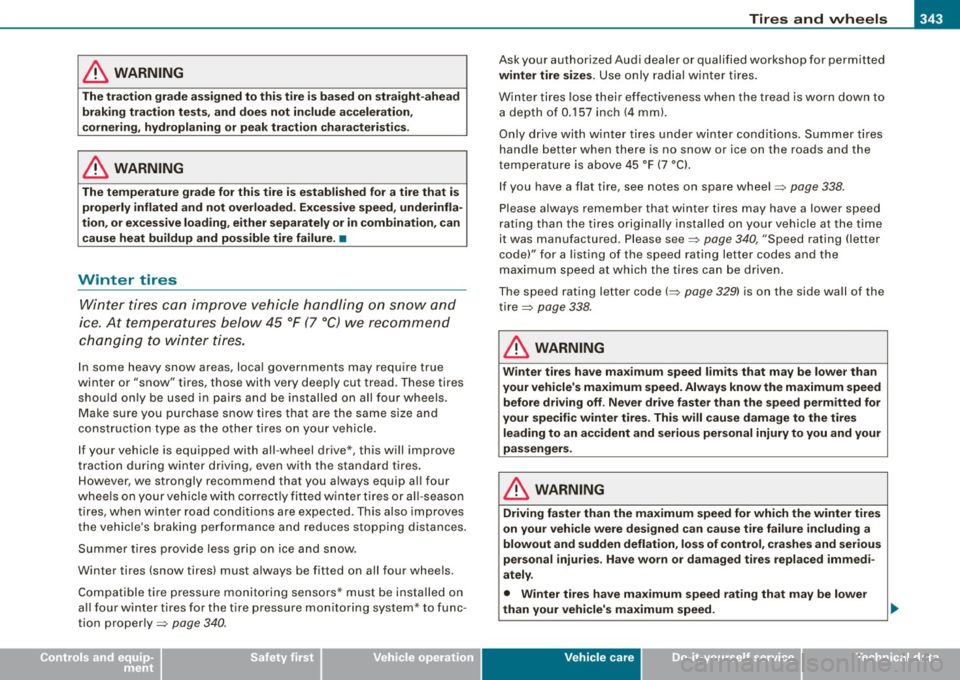
________________________________________________ T_ i _r_e _s_ a_n_ d_ w_ h_ e_e _ l_s __ lllll
•
& WARNING
The tr action grade ass igned to this t ire i s based on straight -ahead
braking traction tests, and does not include acceleration,
c ornering , hydroplaning or peak tra ction chara cteristic s.
& WARNING
The temperature grade for this t ire is established for a tire that is
properly inflated and not overloaded. Excessive speed , underinfla
tion , or ex ces sive loading , either separately or in combination , can
c ause heat buildup and possible tire failure . •
Winter tires
W inter tires c an im prove vehicle handli ng on snow and
ice. At t emperatures belo w 45 °F (7 ° C) we re comme nd
cha ngi ng to wint er tires.
In some heavy snow areas, local governments may require true
winter o r "snow" tires, those with very deeply cut tread. These tires
shou ld on ly be used in pairs and be i nstalled on all four wheels .
M ake sure you purchase snow tires that are the same size and
co nstruction type as t he o the r tires on your vehicle .
I f your vehicle is equipped with all -wheel drive *, this will improve
t raction d uring win te r dr iving, eve n with the s ta n dard ti res .
However, we strongly recommend that you always equip a ll four
w hee ls on you r vehic le wi th cor rec tly fit ted w inter tires o r all-season
t ir es, when w inter road co nditions ar e expected . T his also improves
the vehicle 's br aking perfo rmance and reduces stopping distances.
Summer tires p rov ide less gr ip on ice a nd sno w.
Winter tires (snow tires) must a lways be fitted on all four whee ls .
Compatible ti re pres sure monito ring sensors * must be insta lled on
all four wi nte r tires fo r the t ire pressu re mon ito ring system* to fu n c
tion proper ly ~
page 34 0.
Ask your authorized Audi dealer or qualified workshop for permitted
winter tire sizes. Use only ra d ial winter tires .
Winter tires lose their effectiveness when the tread is worn down to
a depth of 0 .157 inch ( 4 mm).
Only d rive wi th winter tires und er w inter cond itio ns. Summer t ires
handle better when there is no snow or ice on the roads and the
t empe ra tu re i s above 4 5 °F (7 °C) .
I f you have a f lat tire, see notes on spare whee l
~ page 338.
Please a lways remember that winter tires may have a lower speed
r ati ng tha n the ti res orig in ally installed o n yo ur veh icl e at the time
it was manufactured . P lease see~
page 340, "Speed rating (letter
c od e)" for a l isti ng of th e speed ratin g le tter codes a nd the
maximum speed at which the tires can be driven.
The s peed ra ting letter code( ~
page 329) is on the side wa ll of the
t ir e ~
page 338 .
& WARNING
Winter tires have ma ximum speed limits that may be lower than
your vehicle's maximum speed . Always know the maximum speed
before driving off . Never drive faster than the speed permitted for
your specifi c winter tires. This will cause damage to the tires
leading to an accident and serious personal injury to you and your
passengers .
& WARNING
Driving faster than the maximum speed for which the winter tires
on your vehicle were designed can cause tire failure including a
blowout and sudden deflation , loss of control , crashes and serious
personal injuries. Have worn or damaged tires replaced immedi
ately.
• Winter tires have maximum speed rating that may be lower
than your vehicle's maximum speed.
Vehicle care
I t •
Page 346 of 408
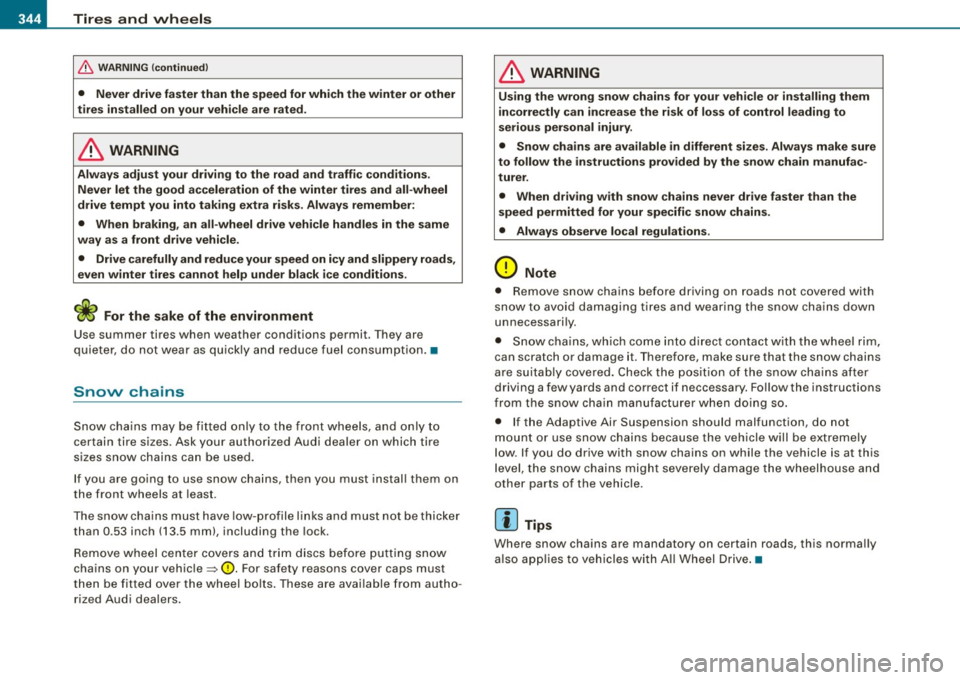
-~_T_ ir_e_ s_ a_ n_d _ w_ h_ e_e _l_s _________________________________________________ _
& WARN ING (continued )
• Never drive fa ster than the speed for which the winter or other
tires in stalled on your vehi cle a re rated.
& WARNING
Always adjust your driving to the road and t raffic condit ions .
Never let the good acceleration of the winter tires and all -wheel
drive tempt you into tak ing extra risks. Always remember :
• When braking , an all -wheel drive vehicle handles in the same
way as a front drive vehicle .
• Drive carefully and reduce your speed on icy and slippery ro ads ,
even winter tires cannot help under bla ck ice conditions.
c£> For the sake of the environment
Use summer tires when weather conditions permit. They are
quieter, d o not wea r as qu ick ly a nd r educe fuel cons ump tio n.•
Snow chains
Sn ow chains may be fitte d only to th e fron t w hee ls, and o nly t o
certain tire sizes . Ask your authorized Audi dealer on which tire
s iz es snow c hains can be used .
If you are going to use snow cha ins , then you must instal l them on
the front wheels at least.
The snow chains must have low-pro file l inks and mus t n ot be thicker
than 0.53 inch ( 13.5 mm), including the lock.
Remove wheel cen ter c ove rs a nd trim discs be fore putti ng snow
chains on your vehic le~
0 . For safety reasons cover caps must
then be fitted ove r the wheel bo lts . These are avai lable from autho
rized Audi dealers.
& WARNING
Using the wrong snow chain s for your vehicle or installing them
incorrectly can in crease the risk of loss of control leading to
serious personal injury .
• Snow chains are available in different size s. Alway s make sure
to follo w the instructions pro vided by the snow chain manufac
turer.
• When dr iving with snow ch ains never drive faster than the
speed permitted for your specific snow chains .
• Always observe local regulations .
0 Note
• Remove snow chains before driving on roads not covered with
snow to av oid da maging t ires a nd weari ng the snow cha ins dow n
unnecessari ly.
• Snow cha ins, wh ic h come into d irect contact wit h the wheel rim ,
can scratch or damage it. Therefore, make sure that the snow chains
a re suitab ly cove red. Check the p osit io n of the snow cha ins a fter
driving a few yards and correct if neccessary. Follow the instructions
from t he s now cha in manufac turer w he n do ing so .
• I f the Adaptive Air Suspension should malfunction , do not
mo unt or us e snow chains becaus e th e veh icle will be extre m ely
l ow . If you do drive with snow chains on while the vehicle is at this
l evel, the s now c hai ns mig ht s ever ely da mag e th e wheel house and
other parts of the vehicle.
[ i ] Tips
Where snow chains are mandatory on certain roads, this norma lly
a lso app lies to veh ic les wi th A ll Wheel Drive .•
Page 347 of 408
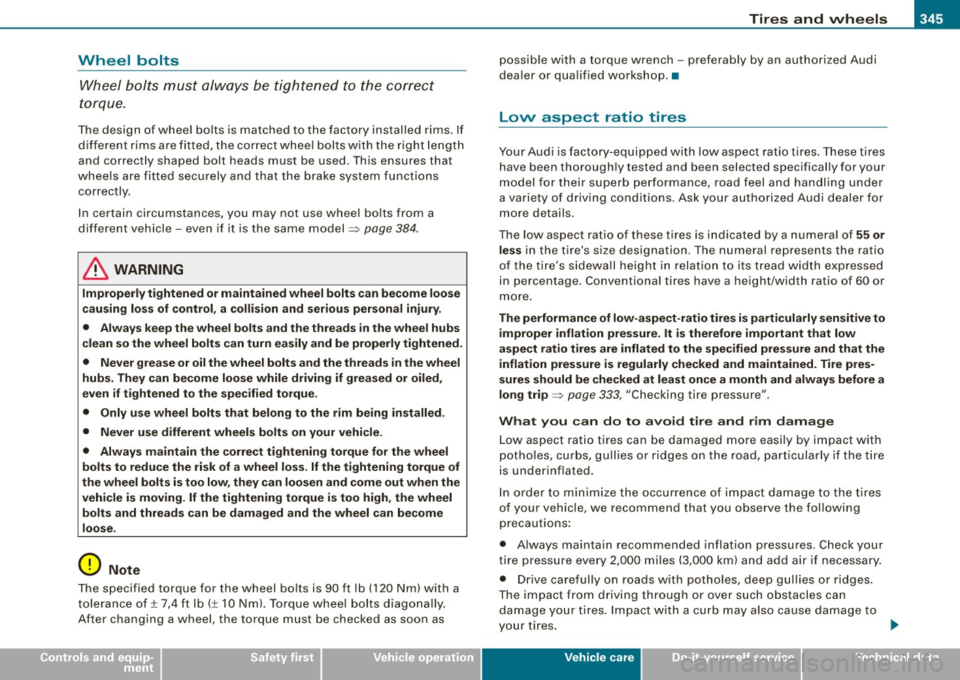
Tires and wheels 1111111 ________________________________ ::..:..:....::.=.....::.:..:..:..::..:___:__ _ ___:,___
•
Wheel bolts
Wheel bolts mus t alwa ys be tighte ned to t he correct
to rq ue .
The design of wheel bo lts is matched to the factory installed rims. If
di fferent r ims are fitted , th e cor rect whe el bo lts wi th the rig ht l ength
and c orrec tly shaped bolt heads must be used . This ens ures that
w he els a re fitted se cur ely and th at the bra ke syste m functi ons
correctl y.
In cer ta in c ircums tances, yo u ma y not use w hee l bolts fr om a
differ ent vehicle - even if it is the same model~
page 384 .
& WARNING
Improperly tightened or maintained wheel bolts can become loose
causing loss of control, a collision and serious personal injury.
• Always keep the wheel bolts and the threads in the wheel hubs
clean so the wheel bolts can turn easily and be properly tightened .
• Never grease or oil the wheel bolts and the threads in the wheel
hubs. They can become loose while driving if greased or oiled,
even if tightened to the specified torque .
• Only use wheel bolts that belong to the rim being installed .
• Never use different wheels bolts on your vehicle.
• Always maintain the correct tightening torque for the wheel
bolts to reduce the risk of a wheel loss .
If the tightening torque of
the wheel bolts is too low, they can loosen and come out when the
vehicle is moving . If the tightening torque is too high, the wheel
bolts and threads can be damaged and the wheel can become
loose .
0 Note
The s pecified torque for the wheel bolts is 90 ft lb ( 120 N m) with a
to lerance o f± 7,4 ft lb(± 1 0 Nm). Torque whee l bolt s diago nally.
After chang ing a whee l, the torque must be checked as soon as possible with a torque wrench
-preferably by an authorized Audi
d e aler o r qua lifi ed wo rksho p.•
Low aspect ratio tires
You r A ud i is fac tory-eq uippe d w ith low aspect ra tio tire s. T hese tire s
have been thorough ly t ested and b een se lected specifica lly for your
mod el for thei r su p erb pe rf or manc e, r oad f eel an d ha nd ling under
a variety of driving con ditions . As k your authorized Audi d ealer for
m ore de ta ils.
The low aspect rat io o f th ese t ires is indicated by a numer al of 55 or
less in the t ire's size designation. The numeral rep resents the ratio
o f t he t ire's s idewa ll he ig ht in rel ati on to it s tread w idt h ex pressed
in percentage . Conventiona l tires have a height/width ratio of 60 or
mo re.
The performan ce of low -aspe ct-ratio tires is particularly sensitive to
improper inflation pressure . It is therefore important that low
aspect ratio tires are inflated to the specified pressure and that the
inflat ion pressure is regularly checked and ma intained. Tire pres
sures should be checked at least once a month and always before a
long trip~
page 333, "Checking tire pressure" .
What you can do to avoid tire and rim damage L ow aspect ratio tires can be damaged mo re easily by impact with
po tho les, cu rbs, gull ies o r rid ges o n th e road, particular ly if the t ire
is underinf lated .
I n or der to mini mize th e occurrence of i mpac t da mag e to t he tires
of your vehicle, we recommend that you observe the fol lowing
pr ecaut ions :
• Always ma intain recom mended inflatio n pr essu res . C heck you r
ti re p ressu re eve ry 2,000 mi les (3,000 k m) and add a ir if neces sary .
• D rive carefully on roads with potho les, deep gullies or ridges.
T he impact from d riving th rough or ove r such obstac les can
da mage y our tires. I mpact with a cu rb m ay a lso cause damage to
your tire s. ..,
Vehicle care
I t •
Page 348 of 408
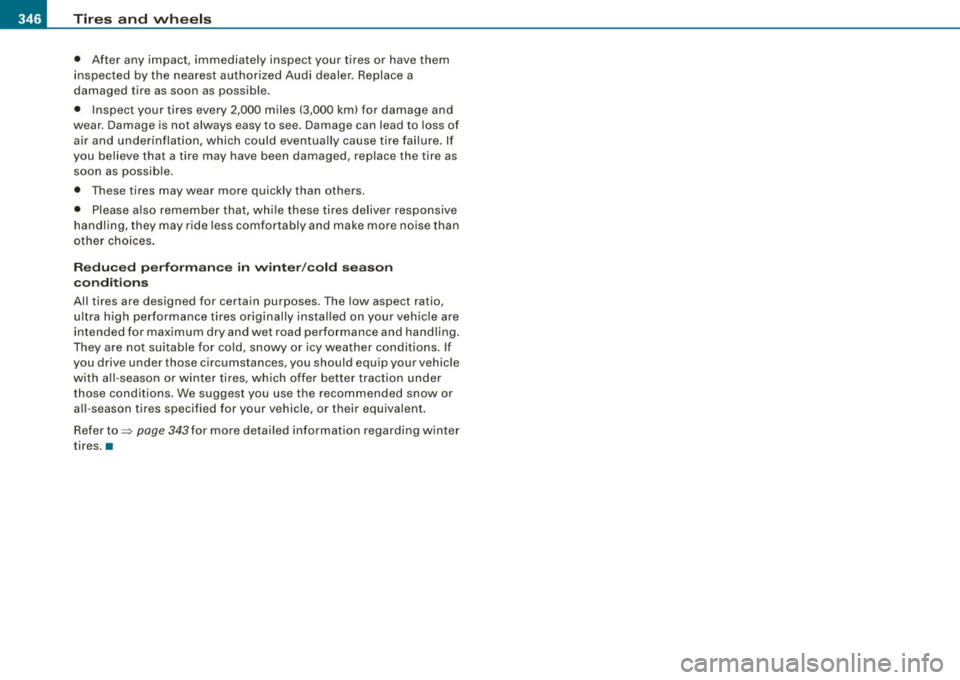
-~_T_ ir_e_ s_ a_ n_d _ w_ h_ e_e _l_s _________________________________________________ _
• After any impact, immediately inspect your tires or have them
inspected by the nearest authorized Audi dealer. Replace a
damaged tire as soon as possib le .
• Inspect your tires every 2,000 miles (3,000 km) for damage and
wear. Damage is not always easy to see. Damage can lead to loss of
air and underinflation, which could eventua lly cause tire failure. If
you believe that a tire may have been damaged, replace the tire as soon as possible .
• These tires may wear more quickly than others.
• Please a lso remember that, whi le these tires deliver responsive
handling, they may ride less comfortably and make more noise than
other choices.
R educ ed p erform an ce in win ter/c old s eason
c ondi tio ns
All tires are designed for certain purposes. The low aspect ratio,
u ltra high performance tires originally ins tal led o n your vehicle are
intended for maximum dry and wet road performance and hand ling.
They are no t suitable for cold, snowy or icy weather conditions . If
you drive under those circumstances, you should equip your vehicle
with al l- season or winter tires, which offer better traction under
those conditions. We suggest you use the recommended snow or
a ll-season tires specified for your vehicle, or their equiva lent.
Refer to~
page 343for more detai led information regarding winter
tires. •
Page 349 of 408
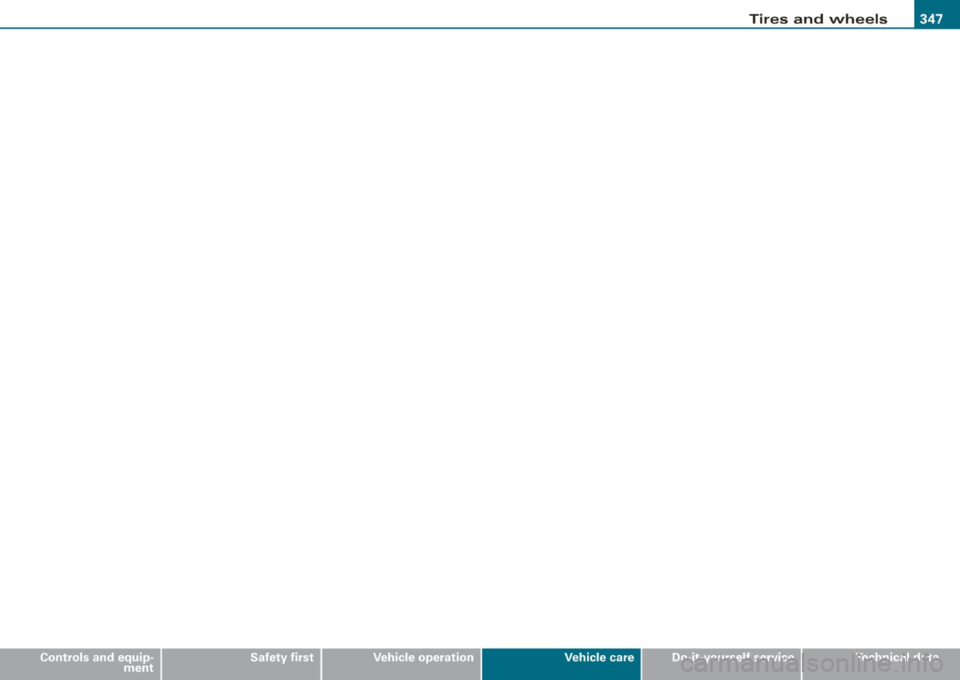
________________________________________________ T_ i _r_e _s_ a_n_ d_ w_ h_ e_e _ l_s __ PII
• Vehicle care I t •
Page 350 of 408
